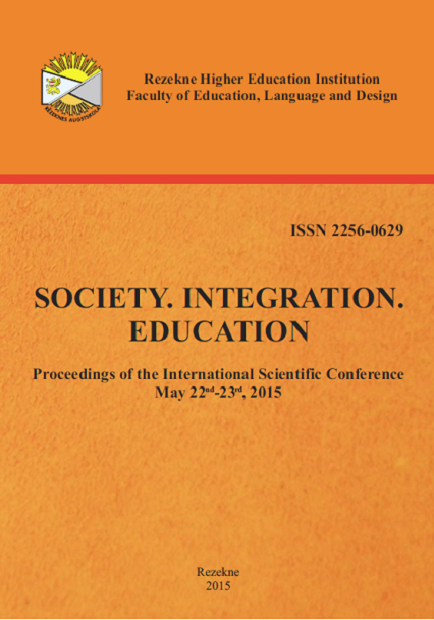Pragmatic Language Level in Autism Spectrum Disorders from the Perspective of Speech and Language Therapy in the Czech Republic
DOI:
https://doi.org/10.17770/sie2015vol3.384Keywords:
spectrum disorder, speech and language therapy, pragmatic language level, diagnosis, assessment, special educationAbstract
The objective is an overview of the partial research outcomes aimed at evaluating the pragmatic level of communication (PCL) in persons with autism spectrum disorder (ASD) from the perspective of speech and language therapy (SLT) in the Czech Republic, where the SLT system is divided into three different sectors bringing specific views on their concept. A partial objective is to highlight the need to create specific SLT diagnostic materials for national- relevant use and outline their concept. It is based on a brief theoretical analysis of the current state of knowledge, and presents the quantitative and qualitative outcomes based on a mixed research design. Partial results confirm the lack of practical SLT´s focus on the area of PCL diagnosis in ASD, the lack of relevant diagnostic materials as well as effective options of SLT intervention in PCL of people with (ASD) focusing on selected individually impaired factors.
Downloads
References
Attwood, T. (2008). The complete guide to Asperger´s syndrome. London: Jessica KingsleyPublishers.
Bondy, A., &Frost, L. (2007). Vizuální komunikační strategie v autismu. [A Picture's Worth: PECS and Other Visual Communication Strategies in Autism]. Praha: Grada.
Boyd, B. (2011). Výchova dítěte s Aspergerovým syndromem. [Parenting a Child with Asperger Syndrome]. Praha: Portál.
Čadilová, Z., Thorová, K., Žampachová, Z. a kol. (2012). Katalog posuzování míry speciálních vzdělávacích potřeb, část II. Diagnostickédomény pro žáky s poruchamiautistickéhospektra.[Catalogue for assessing the degree of special educational needs, Part II. Diagnostic domains for pupils with autistic spectrum disorders]. Olomouc: UniverzitaPalackého v Olomouci.
Cséfalvay, Z.,Lechta, V. a kol. (2013). Diagnostikanarušenékomunikačníschopnosti u dospělých. [Diagnosis of communication disorders in adults]. Praha: Portál.
Dotazníkfunkcionálníkomunikace (DFK). (2013). FakultnínemocniceBrno. [Questionnaire of functional communication (QFC)]. [cit. 2014-04-06]. Retrieved from http://www.fnbrno.cz/nemocnice-bohunice/neurologicka-klinika/dotaznik-funkcionalni-komunikace-dfk/t4546.
Ehlers, S., Nydén, A., Johansson, M., Gillebg, CH. (1996). Language and pragmaticfunctions in school-agechildren on theautismspectrum. International JournalofLanguage&CommunicationDisorders. 31, (4), 387-413.
Greenspan, S. I.,Shanken, S. G. (2004). Der erstegedanke. FrühkindlicheKommunikationunddieEvolutionmenschlichenDenkens.[The first thought. Early childhood communication and the evolution of human thought]: Beltz.
Grigorenko, E., Klin, A, Volkmar, F. (2003). Hyperlexia: disability or superability? Journal of Child Psychology and Psychiatry, 44, 1079–1091.
Grimmová, H., Schöler, H., &Mikulajová, M. (1997). Heidelbergský test vývoje řeči H-S-E-T. 2. Brno: Psychodiagnostika. [Heidelberg test of speech development H-S-E-T. 2. Brno: Psychodiagnosis.]
Howlin, P. (2005). Autismus u dospívajících a dospělých. Praha: Portál. [Autism in adolescentsandadults]
Jelínková, M. (2009). Vzdělávání a výchova dětí s autismem.[Training and education of children with autism. Prague: IPPP]. Praha: IPPP.
Koukolík, F. (2002). Lidský mozek: funkční systémy, normy a poruchy. [The human brain: Functional systems, standards and disorders]. Praha: Portál.
Lechta, V. a kol (2011). Terapienarušenékomunikačníschopnosti. [Therapy of impaired communication skills. Prague: Portal]. Praha: Portál.
Lechta, V. a kol. (2003). Diagnostikanarušenékomunikační schopnosti. [Diagnosis of impaired communication skills]. Praha: Portál.
Mikudová, H. (2014). Pragmatická jazyková rovina u osob s poruchami autistického spektra. [Pragmatic language level in individuals with autism spectrum disorders]. Olomouc. Diplomová práce. Supervisor: Říhová.
Mikulajová, M. (2003). Diagnostikanarušenéhovývojeřeči.[Diagnosis of impaired speech development]. In Lechta, V. et. al. Diagnostikanarušenékomunikačníschopnosti. Diagnosis of impaired communication skills]. Praha: Portál.
Newman, T. M., Macomber, D., Naples, A. J., Babitz, T, Volkmar, F., Grigorenko, E. L. (2007). Hyperlexia in children with autism spectrum disorders. Journal of Autism and Developmental Disorders. 37(4), 760-74.
Reisinger, L., Cornish, K., &Fomboone, E. (2011). DiagnosticDifferentiationofAutismSpectrumDisorders and PragmaticLanguageImpairment. JournalofAutism&DevelopmentalDisorders. 41 (12), 1694-1704
Richman, S. (2008). Výchovadětí s autismem: aplikovanábehaviorálníanalýza.[Raising a child with autism: A guide Applied Behavioural Analysis]. Praha: Portál.
Říhová, A.,Vitásková, K. (2012). Logopedickáintervence u osob s poruchamiautistickéhospektra. Odbornápublikace pro logopedy. [Speech language and lantherapy intervention in individuals with autism spectrum disorders. Professional publication for speech and language therapists]. Olomouc: UniverzitaPalackého v Olomouci. WOS:000329385700011
SocialLanguage Use (Pragmatics).(2015). cit. [2015-1-14]. AmericanSpeech-Language-Hearing Association ASHA. Retrievedfromhttp://www.asha.org/public/speech/development/pragmatics.htm
Tesing, C. M. J., Buitelaar, J. K, Petersson, K. M. (2009). cit. [2013-12-19]. Neural correlates of pragmatic language comprehension in autism spectrum disorders. Dostupné z: http://brain.oxfordjournals.org/content/132/7/1941.short.
Thorová, K. (2006). Poruchy autistického spektra.[Autism spectrum disorder]. Praha: Portál.
Vitásková, K., Říhová, A. (2014). Trans-disciplinaryCooperation in ChildrenwithAutismSpectrumDisorderInterventionwithEmphasis on theSpeech and LanguageTherapist'sImportant Role.ProcediaSocial and BehavioralSciences. 132, 310-317
Volden, J., Phillips, L. (2010).Measuring pragmatic language in speakers with autism spectrum disorders: Comparing the children's communication checklist--2 and the test of pragmatic language. AmericanJournalofSpeech-LanguagePathology. 2010, 19 (3), 204-212.
Volden, J., Coolican, J., Garon, N., Whote, J.,Bryson, S. (2008). Brief Report: PragmaticLanguage in AutismSpectrumDisorder: Relationships to MeasuresofAbility and Disability.[cit. 2014-04-05]. JournaloAutism and DevelopmentalDisorders, 39(2), 388-393 Retrievedfrom http://eds.a.ebscohost.com/eds/detail?vid=2&sid=d6c901d2-e5a1-48bb-af67-a%40sessionmgr4001&hid=4213&bdata=Jmxhbmc9Y3Mmc2l0ZT1lZHMtbGl2ZQ%3d%3d#db=edselc&AN=edselc.2-52.0-58549115047.
Vrbová, R. et al. (2012). Katalog posuzování míry speciálních vzdělávacích potřeb. Část II. (Diagnostické domény pro žáky s narušenou komunikační schopností). [Catalogue for assessing the degree of special educational needs, Part II. Diagnostic domains for pupils with impaired communication skills]. Olomouc: Univerzita Palackého v Olomouci. Wallace L.G. (2008). Neuropsychological studies of savant skills: Can they inform the neuroscience of giftedness? Roeper Review, 30, 229-246.


